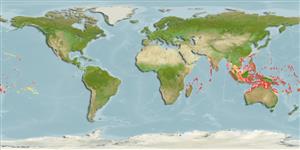>
Perciformes/Serranoidei (Groupers) >
Liopropomatidae (Painted basslets) > Diploprioninae
Etymology: Belonoperca: Greek, belone = needle; any fish with sharp pointed snout; also Pierre Belon, 1517-64, French zoologist born in Le Mans. Professor at the College de France, author of " La nature et diversité des poissons", 1551 + Greek, perke = perch (Ref. 45335).
More on authors: Fowler & Bean.
Environment: milieu / climate zone / depth range / distribution range
Ökologie
seewasser riff-verbunden; tiefenbereich 4 - 50 m (Ref. 9710). Tropical; 30°N - 23°S
Indo-Pacific: East Africa to Samoa, north to the Ryukyu Islands, south to New Caledonia.
Size / Gewicht / Alter
Maturity: Lm ? range ? - ? cm
Max length : 15.0 cm TL Männchen/unbestimmt; (Ref. 9710)
Rückenflossenstacheln (insgesamt): 9; Rückenflossenweichstrahlen (insgesamt): 10; Afterflossenstacheln 2; Afterflossenweichstrahlen: 8. Body brown in color (may also be dusky bluish grey to almost black (Ref. 48635)), caudal peduncle with saddle-like yellow spot; large ocellated black spot on spinous dorsal (Ref. 4326).
Occurs in steep slopes of coral rich areas. Usually hovers in mid water in caves (Ref. 9710). Nocturnal species (Ref. 4326). Secretive and solitary (Ref. 37816). Feeds on small fishes and crustaceans (Ref. 89972). Easily missed and normally the yellow spot is noticed first (Ref. 48635). Produces the skin toxin grammistin.
Life cycle and mating behavior
Geschlechtsreife | Fortpflanzung | Ablaichen | Eier | Fecundity | Larven
Randall, J.E., G.R. Allen and R.C. Steene, 1990. Fishes of the Great Barrier Reef and Coral Sea. University of Hawaii Press, Honolulu, Hawaii. 506 p. (Ref. 2334)
IUCN Rote Liste Status (Ref. 130435)
Bedrohung für Menschen
Harmless
Nutzung durch Menschen
Mehr Information
NamenSynonymeMetabolismusRäuberÖkotoxikologieFortpflanzungGeschlechtsreifeAblaichenSpawning aggregationFecundityEierEientwicklung
ReferenzenAquakulturAquakultur ProfilZuchtlinienGenetikElectrophoresesVererbbarkeitKrankheitenVerarbeitungNutrientsMass conversion
PartnerBilderStamps, Coins Misc.LauteCiguateraGeschwindigkeitSchwimmstilKiemenoberflächeOtolithsGehirngrößeSehfähigkeit
Tools
Zusatzinformationen
Download XML
Internet Quellen
Estimates based on models
Preferred temperature (Ref.
123201): 25.8 - 28.8, mean 27.6 °C (based on 426 cells).
Phylogenetic diversity index (Ref.
82804): PD
50 = 0.7500 [Uniqueness, from 0.5 = low to 2.0 = high].
Bayesian length-weight: a=0.00389 (0.00180 - 0.00842), b=3.12 (2.94 - 3.30), in cm total length, based on all LWR estimates for this body shape (Ref.
93245).
Trophic level (Ref.
69278): 4.0 ±0.67 se; based on food items.
Fishing Vulnerability (Ref.
59153): Low vulnerability (10 of 100).
Nutrients (Ref.
124155): Calcium = 84 [48, 177] mg/100g; Iron = 0.642 [0.326, 1.169] mg/100g; Protein = 18 [16, 20] %; Omega3 = 0.115 [0.065, 0.210] g/100g; Selenium = 29.4 [14.0, 62.4] μg/100g; VitaminA = 140 [42, 500] μg/100g; Zinc = 1.42 [0.90, 2.14] mg/100g (wet weight);
